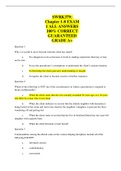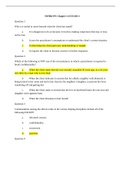Swrk 379 Study guides, Class notes & Summaries
Looking for the best study guides, study notes and summaries about Swrk 379? On this page you'll find 3 study documents about Swrk 379.
All 3 results
Sort by

-
SWRK379: Chapter 1-8 EXAM 1 ALL ANSWERS 100% CORRECT GUARANTEED GRADE A+
- Exam (elaborations) • 15 pages • 2021
-
- $15.99
- + learn more
Why is it useful to move beyond what the client has stated? a. It is dangerous to do so because it involves making conjectures that may or may not be true. b. It uses the practitioner’s assumptions to understand the client’s current situation. c. It often helps the client gain new understanding or insight. d. It requires the client to become creative in his/her responses. Question 2 Which of the following is NOT one of the circumstances in which a practitioner is required to break...
![SWRK379: Chapter 1-8 EXAM ]1 AnswersSWRK379: Chapter 1-8 EXAM 1 Answers]](/docpics/61b70edd736e9_1438741.jpg)
-
SWRK379: Chapter 1-8 EXAM ]1 AnswersSWRK379: Chapter 1-8 EXAM 1 Answers]
- Exam (elaborations) • 15 pages • 2021
-
- $17.29
- + learn more
SWRK379: Chapter 1-8 EXAM 1 Question 1 Why is it useful to move beyond what the client has stated? a. It is dangerous to do so because it involves making conjectures that may or may not be true. b. It uses the practitioner’s assumptions to understand the client’s current situation. c. It often helps the client gain new understanding or insight. d. It requires the client to become creative in his/her responses. Question 2 Which of the following is NOT one of the circumstances in ...

-
SWRK379: Chapter 1-8 EXAM 1 Answers
- Exam (elaborations) • 15 pages • 2021
-
- $19.49
- + learn more
SWRK379: Chapter 1-8 EXAM 1 Question 1 Why is it useful to move beyond what the client has stated? a. It is dangerous to do so because it involves making conjectures that may or may not be true. b. It uses the practitioner’s assumptions to understand the client’s current situation. c. It often helps the client gain new understanding or insight. d. It requires the client to become creative in his/her responses. Question 2 Which of the following is NOT one of the circumstances in whic...

Did you know that on average a seller on Stuvia earns $82 per month selling study resources? Hmm, hint, hint. Discover all about earning on Stuvia


